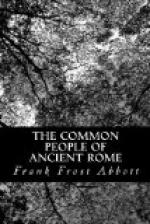XXIV
1 Genuine purple silk, per pound $652.20 2 Genuine purple wool, per pound $217.40 3 Genuine light purple wool, per pound $139.26 8 Nicaean scarlet wool, per pound $6.53
XXV
1 Washed Tarentine wool, per pound 76 cents 2 Washed Laodicean wool, per pound 65 " 3 Washed wool from Asturia, per pound 43.5 " 4 Washed wool, best medium quality, per pound 21.7 " 5 All other washed wools, per pound 10.8 "
XXVI
7a Coarse linen thread, first quality, per pound $3.13 8 Coarse linen thread, second quality, per pound $2.61 9 Coarse linen thread, third quality, per pound $1.96
XXX
1 Pure gold in bars or in coined pieces, per pound 50,000 denarii 3 Artificers, working in metal, per pound $21.76 4 Gold-beaters, per pound $13.06
Throughout the lists, as one may see, articles are grouped in a systematic way. First we find grain and vegetables; then wine, oil, vinegar, salt, honey, meat, fish, cheese, salads, and nuts. After these articles, in chapter VII, we pass rather unexpectedly to the wages of the field laborer, the carpenter, the painter, and of other skilled and unskilled workmen. Then follow leather, shoes, saddles, and other kinds of raw material and manufactured wares until we reach a total of more than eight hundred articles. As we have said, the classification is in the main systematic, but there are some strange deviations from a systematic arrangement. Eggs, for instance, are in table VI with salads, vegetables, and fruits. Buecher, who has discussed some phases of this price list, has acutely surmised that perhaps the tables in whole, or in part, were drawn up by the directors of imperial factories and magazines. The government levied tribute “in kind,” and it must have provided depots throughout the provinces for the reception of contributions from its subjects. Consequently in making out these tables it would very likely call upon the directors of these magazines for assistance, and each of them in making his report would naturally follow to some extent the list of articles which the imperial depot controlled by him, carried in stock. At all events, we see evidence of an expert hand in the list of linens, which includes one hundred and thirty-nine articles of different qualities.




